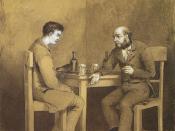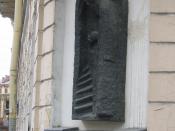In "Crime and Punishment" one witnesses a murder as it is graphically described by Fyodor Dostoevsky. How, after such a graphic display of evil, can the reader be compassionate towards Raskolnikov? Superficially, Rodion Raskolnikov appears purely evil, but readers become sympathetic towards his character through in a depth scrutiny of his personality. The full presentation of Raskolnikov's thoughts reveals his true reasoning behind his crime. Dostoevsky rationalizes Raskolnikov's actions by bringing the reader into an intimate relationship with his character. The reader sees the many ways Raskolnikov attempts to justify his actions to himself. The terrible illness that Raskolnikov takes on following the murder is another reason to pity him. As readers are finally able to forgive Raskolnikov in their minds, they realize that he was not evil, even good to a point.
Raskolnikov tries many times to rationalize the murder, even before he actually commits it. The time and effort he spends attempting to justify his actions seem to make him appear more human.
He shows a benevolent side by tossing any money he happens to have at the first needy person he sees. He uses this need to help others as one justification of the murder. By killing one useless woman he can do innumerable good deeds. Raskolnikov heard his own ideas echoed by some youth in the hay market. One said "What do you think, would not one tiny crime be wiped out by thousands of good deeds?" (59) The notion of committing a crime for the purpose of good serves to give Raskolnikov a benevolent appearance despite his actions. The fact that the pawn broker was a human did not faze him as he saw her as a pest. In turn, he was killing a "louse" for the purpose of making the world a better...



Great work!
I just finished Crime and Punishment myself for AP English IV, so I can appreciate the effort you've put into this paper.
0 out of 0 people found this comment useful.